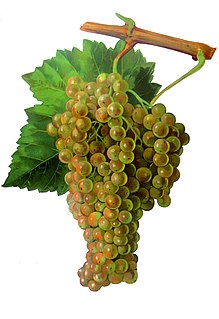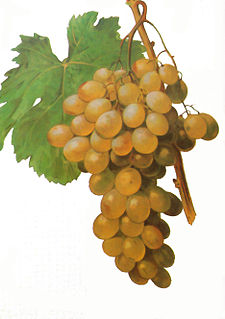
Vinho Verde refers to Portuguese wine that originated in the historic Minho province in the far north of the country. The modern-day 'Vinho Verde' region, originally designated in 1908, includes the old Minho province plus adjacent areas to the south. In 1976, the old province was dissolved.

Trebbiano is an Italian wine grape, one of the most widely planted grape varieties in the world. It gives good yields, but tends to yield undistinguished wine. It can be fresh and fruity, but does not keep long. Also known as ugni blanc, it has many other names reflecting a family of local subtypes, particularly in Italy and France. Its high acidity makes it important in Cognac and Armagnac productions.

Alvarinho or Albariño is a variety of white wine grape grown in Northwest Portugal and Galicia where it is also used to make varietal white wines. In Portugal it is known as Alvarinho, and sometimes as Cainho Branco, Albariño is the Galician name for the grape.

Portuguese wine was mostly introduced by the Romans and other ancient Mediterranean peoples who traded with local coastal populations, mainly in the South. In pre-Roman Gallaecia-Lusitania times, the native peoples only drank beer and were unfamiliar with wine production. Portugal started to export its wines to Rome during the Roman Empire. Modern exports developed with trade to England after the Methuen Treaty in 1703. From this commerce a wide variety of wines started to be grown in Portugal. And, in 1758, one of the first wine-producing regions of the world, the Região Demarcada do Douro was created under the orientation of Marquis of Pombal, in the Douro Valley. Portugal has two wine-producing regions protected by UNESCO as World Heritage: the Douro Valley Wine Region and Pico Island Wine Region. Portugal has a big variety of local kinds, producing a very wide variety of different wines with distinctive personality.

Mencía, known as Jaen in Portugal, is a grape variety native to the western part of the Iberian Peninsula. In Spain, it is planted on over 9,100 hectares, with another 2,500 hectares in neighboring Portugal. It is primarily found in the Bierzo, Ribeira Sacra, Valdeorras, Monterrei and Dão wine regions.

Muscat of Alexandria is a white wine grape that is a member of the Muscat family of Vitis vinifera. It is considered an "ancient vine", and wine experts believe it is one of the oldest genetically unmodified vines still in existence. The grape originated in North Africa, and the name is probably derived from its association with Ancient Egyptians who used the grape for wine making. It is also a table grape used for eating and raisins.

Sezão, formerly known as Souzão, is a Portuguese wine grape that is used in the production of port wine and table wines.

Minho, formerly Rios do Minho, is a Portuguese wine region covering the same areas as the Vinho Verde DOC. The region is classified as a Vinho Regional (VR), a designation similar to a French vin de pays region. The wines of the Minho and Vinho Verde are nearly identical except for the Minho VR allowing foreign grape varieties to be used that are excluded from the Denominação de Origem Controlada (DOC) regulations for Vinho Verde.
Arinto or Arinto de Bucelas is a white Portuguese wine grape planted primarily in the Bucelas, Tejo and Vinho Verde regions. It can produce high acid wines with lemon notes.
Avesso is a white Portuguese wine grape planted primarily in the Minho region of Portugal. It can make full-bodied aromatic wines. Ampelographers believe it may be related to the Portuguese grape Jaen.
Azal branco is a white Portuguese wine grape planted primarily in the Minho region but with greater expansion to Amarante, Basto, Baião and Vale do Sousa sub-regions. It noted for the high acidity of its wines, and is used for white Vinho Verde. Varietal Azal Branco wines can be somewhat reminiscent of Riesling.

Cayetana blanca, also known as Cayetana or Jaén, is a white Spanish wine grape. It is grown mainly in the south of Spain, especially in Extremadura and in the Jerez region where it is distilled for use in brandy production.
Azal Tinto or Amaral is a variety of red Portuguese wine grape. It is planted in the Minho region where it is used in red Vinho Verde, while the related Azal Branco is used for white Vinho Verde.
Rabo de Ovelha is white Portuguese wine grape variety that is grown all over Portugal. It should not be confused with the red Rabo de Anho grape variety that is found in the Vinho Verde region. Rabo de Ovelha is an authorized grape variety in the Bairrada, Borba, Bucelas, Redondo, Reguengos, Setúbal and Vidigueira Denominação de Origem Controlada (DOC). The grape variety gets its name from the way its grape bunches resembles the end of a ewe's tail. In winemaking, Rabo de Ovelha is known for producing highly alcoholic wines that wine expert Jancis Robinson describes as lacking subtlety.

Treixadura or Trajadura is white Portuguese wine grape variety grown primarily in the Vinho Verde wine region of northeast Portugal and the Galician wine regions of Ribeiro and Rías Baixas in Spain where the variety is known as Treixadura. The grape is primarily a blending variety that adds body and light lemony aromatics to wines. It is most commonly blended with Loureiro and Alvarinho in Rías Baixas while in Ribeiro it is often blended with Torrontés and Lado.
Terrantez is a white Portuguese wine grape variety that was once widely used on the island of Madeira to make the sweet fortified wine for which the island is known. Today, the variety is nearly extinct on the island. There are still some limited plantings in the Minho Province where, as Cascal, is a permitted blending variety with Alvarinho and other grapes in the Denominação de Origem Controlada (DOC) wine Vinho Verde. As Terrantez the grape is permitted in several of the Indicação de Proveniencia Regulamentada (IPR) regions of the Azores including Biscoitos IPR on Terceira Island, Graciosa IPR on the white island of Graciosa and Pico IPR on Pico Island.
Caíño blanco or Cainho branco is a white Spanish and Portuguese wine grape variety that is grown in northwest Spain and northern Portugal in a stretch of area between Vinho Verde and the Denominación de Origen (DO) of Rías Baixas. The grape is often confused for Albariño and in Vinho Verde it is sometimes known under the name Alvarinhão. While DNA profiling conducted in the early 21st century has shown that the two grapes are distinct varieties, the evidence has suggested that Caíño blanco maybe an offspring of Albariño from a natural crossing with the red Portuguese wine grape Azal tinto.
Donzelinho branco is a white Portuguese wine grape variety that is classified as one of the "Very Good" varieties authorized to be used in Port wine production. While rarely seen as a varietal wine, Donzelinho branco is a permitted variety in the white blends of several northern Portuguese wine regions including the Denominação de Origem Controlada (DOC) of Douro and Trás-os-Montes and the Vinho Regional (VR) wines of Duriense and Transmontano.

Hebén is a very rare white grape variety grown for wine and table grapes in Spain. It is an ancient variety found to have originated as a table grape in North Africa as Gibi. It is the parent variety of a large number of grapes grown in the Iberian Peninsula and the wider Mediterranean. It has paired with Alfrocheiro to produce the rare Portuguese varieties Trincadeira das pratas, Tinta grossa, Castelão branco, and Malvasia fina, as well as the Spanish Allarén. With Muscat of Alexandria it has produced Moscatel nunes/Nuno gomes in Portugal and Moscatel de Angüés in Spain. In Spain, it has a parent relationship with some very widely grown varieties: Airén, Cayetana, Viura, Xarel·lo, and Pedro Ximénez. In total, around 60 offspring varieties have been identified. Its sparse bunches are an attribute that can be seen some in children varieties such as Pedro Ximénez and Xarello. It produces solely female flowers, unlike the majority of self-pollinating vinifera varieties grown for wine today.











